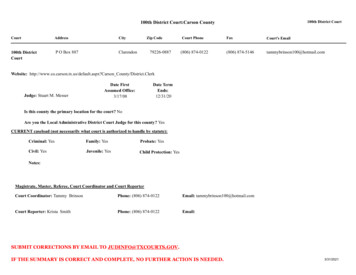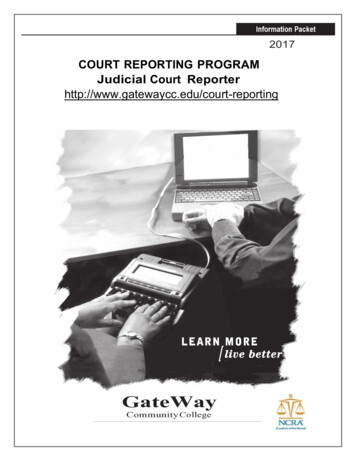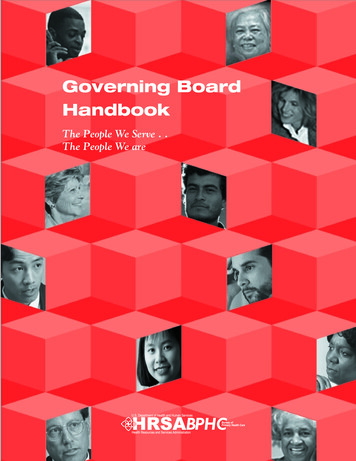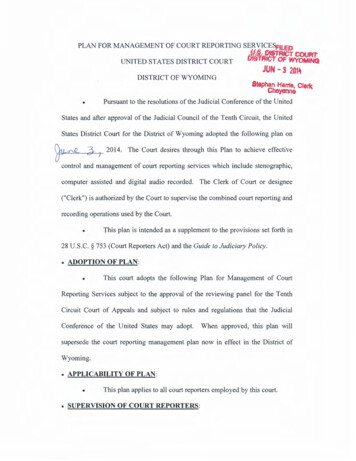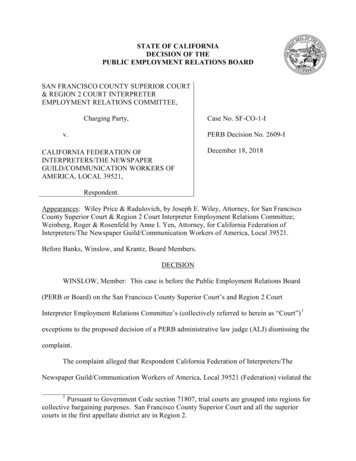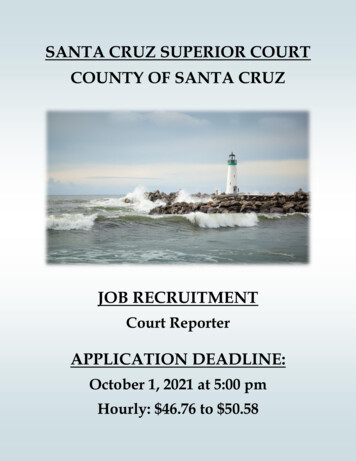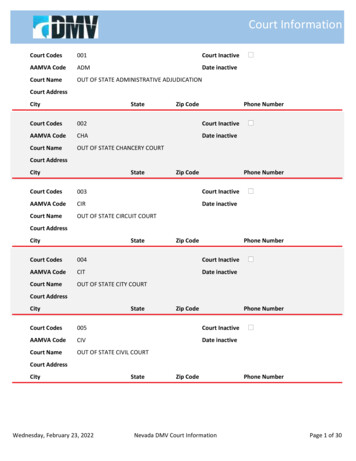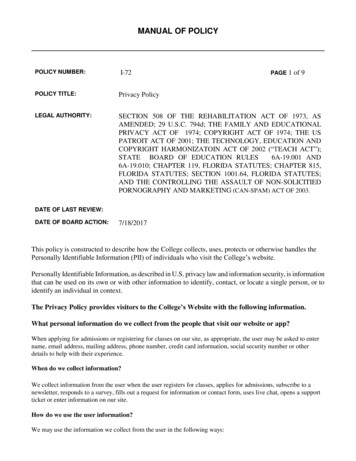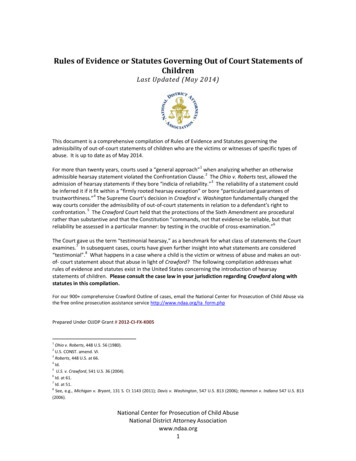
Transcription
Rules of Evidence or Statutes Governing Out of Court Statements ofChildrenLast Updated (May 2014)This document is a comprehensive compilation of Rules of Evidence and Statutes governing theadmissibility of out-of-court statements of children who are the victims or witnesses of specific types ofabuse. It is up to date as of May 2014.1For more than twenty years, courts used a “general approach” when analyzing whether an otherwise2admissible hearsay statement violated the Confrontation Clause. The Ohio v. Roberts test, allowed the3admission of hearsay statements if they bore “indicia of reliability.” The reliability of a statement couldbe inferred it if it fit within a “firmly rooted hearsay exception” or bore “particularized guarantees of4trustworthiness.” The Supreme Court’s decision in Crawford v. Washington fundamentally changed theway courts consider the admissibility of out-of-court statements in relation to a defendant’s right to5confrontation. The Crawford Court held that the protections of the Sixth Amendment are proceduralrather than substantive and that the Constitution “commands, not that evidence be reliable, but that6reliability be assessed in a particular manner: by testing in the crucible of cross-examination.”The Court gave us the term “testimonial hearsay,” as a benchmark for what class of statements the Court7examines. In subsequent cases, courts have given further insight into what statements are considered8“testimonial”. What happens in a case where a child is the victim or witness of abuse and makes an outof- court statement about that abuse in light of Crawford? The following compilation addresses whatrules of evidence and statutes exist in the United States concerning the introduction of hearsaystatements of children. Please consult the case law in your jurisdiction regarding Crawford along withstatutes in this compilation.For our 900 comprehensive Crawford Outline of cases, email the National Center for Prosecution of Child Abuse viathe free online prosecution assistance service http://www.ndaa.org/ta form.phpPrepared Under OJJDP Grant # 2012-CI-FX-K0051Ohio v. Roberts, 448 U.S. 56 (1980).U.S. CONST. amend. VI.3Roberts, 448 U.S. at 66.4Id.5U.S. v. Crawford, 541 U.S. 36 (2004).6Id. at 61.7Id. at 51.8See, e.g., Michigan v. Bryant, 131 S. Ct 1143 (2011); Davis v. Washington, 547 U.S. 813 (2006); Hammon v. Indiana 547 U.S. 813(2006).2National Center for Prosecution of Child AbuseNational District Attorney Associationwww.ndaa.org1
Table of ContentsClick on the state heading to go to the statutes section.ALABAMA . 6Ala. Code § 15-25-31 (2014). Out-of-court statement -- When admissible . 6ALA. CODE § 15-25-32 (2014). Out-of-court statement -- Requirements for admissibility *** FoundUnconstitutional by Styron v. State, 34 So.3d 724 (Ala.Crim.App.,2009) ( Applying Crawford v.Washington to § § (2) and § (b)) . 6ALASKA . 7ALASKA STAT. § 12.40.110 (2014). Hearsay evidence in prosecutions for sexual offenses . 7ARKANSAS . 7A. R.E. Rule 804 (2014). Hearsay Exceptions--Declarant Unavailable . 7CALIFORNIA . 10Cal.Evid.Code § 1228 (2014). Admissibility of certain out-of-court statements of minors under theage of 12; establishing elements of certain sexually oriented crimes; notice to defendant . 10Cal.Evid.Code § 1360 (2014). Statements describing an act or attempted act of child abuse orneglect; criminal prosecutions; requirements . 11COLORADO . 11COLO. REV. STAT. § 13-25-129 (2014). Statements of child victim of unlawful sexual offense against achild or of child abuse--hearsay exception . 11*****Held Unconstitutional By People v. Moreno, 160 P.3d 242, 242 (Colo. Jun 11, 2007) (violatesdefendant's right of confrontation if defendant is not afforded opportunity to cross-examine victim). 11CONNECTICUT . 13DELAWARE. 13DEL. CODE ANN. TIT. 11, § 3513 (2014). Hearsay exception for child victim's or witness's out-of-courtstatement of abuse . 13DISTRICT OF COLUMBIA . 15FLORIDA . 15FLA. STAT. ANN. § 90.803 (2014)Hearsay exceptions; availability of declarant immaterial (23) ChildVictim . 15GEORGIA . 16REPEALED GA. CODE ANN. § 24-3-16 (2013), relating to statements made by child under age of 14years describing acts of sexual contact or physical abuse Repealed by Laws 2011, Act 52, § 2, eff.January 1, 2013 . 16HAWAII . 16IDAHO . 16ILLINOIS . 17725 ILL. COMP. STAT. § 115-10 (2014). Certain hearsay exceptions . 17National Center for Prosecution of Child AbuseNational District Attorney Associationwww.ndaa.org2
INDIANA . 19IND. CODE ANN. § 35-37-4-6 (2014) Application of section; “protected person” defined; applicableoffenses; admissibility of statement or videotape; notice to defendant; jury instructions; hearing asevidence . 19IOWA . 22KANSAS . 22KENTUCKY . 23LOUISIANA . 23MAINE . 23MARYLAND . 23MD. CODE ANN., CRIM. LAW § 11-304 (2014). Out-of-court statements of child victims . 23MASSACHUSETTS . 28MASS. ANN. LAWS CH. 233, § 81(2014) . Criminal proceedings; out-of-court statements describingsexual contact; admissibility . 28MICHIGAN. 29MINNESOTA . 29MINN. STAT. § 595.02, Subd. 3. (2014). certain out-of-court statements admissible . 29MISSISSIPPI . 30Rules of Evid., M.R.E. 803 (25) (2014); Tender Years Exception . 30MISSOURI . 30MO. REV. STAT. § 491.075 (2014). Statement of child under fourteen or vulnerable person admissible,when . 30MONTANA . 31MONT. CODE ANN. § 46-16-220 (2014). Child hearsay exception--criminal proceedings. 32NEBRASKA . 34NEVADA . 34NEV. REV. STAT. ANN. § 51.385 (2014). Admissibility; notice of unavailability or inability of child to testify. 34NEW HAMPSHIRE . 35NEW JERSEY . 35Rules of Evid., N.J.R.E. 803(c)(27) (2014). Statements by a Child Relating to a Sexual Offense. . 35NEW MEXICO . 35NEW YORK . 36NORTH CAROLINA . 36NORTH DAKOTA . 36National Center for Prosecution of Child AbuseNational District Attorney Associationwww.ndaa.org3
Rules of Evid., N.D.R.E. 803(24) (2014). Child's Statement about Sexual Abuse. . 36OHIO . 36Rules of Evid., O.H.R.E. 807(2014). Hearsay exceptions; child statements in abuse cases . 36OKLAHOMA . 38OKLA. STAT. ANN. TIT. 12, § 2803.1 (2014). Statements of children not having attained 13 years orincapacitated persons describing acts of physical abuse or sexual contact--Admissibility in criminal andjuvenile proceedings . 38OREGON . 39Rules of Evid., O.R.R.E. 803 (18a)(2014). Rule 803. Hearsay exception; availability of declarantimmaterial . 39PENNSYLVANIA . 4142 PA. CONS. STAT. ANN. § 5985.1 (2014). Admissibility of certain statements . 41RHODE ISLAND . 42R.I. GEN. LAWS § 40-11-7.2 (2014). Evidence . 42SOUTH CAROLINA . 43S.C. CODE ANN. §§ 17-23-175 (2014).Admissibility of out-of-court statement of child under twelve;determination of trustworthiness; notice to adverse party. . 43SOUTH DAKOTA . 45S.D. CODIFIED LAWS § 19-16-38 (2014). Statement by child under age thirteen or child withdevelopmental disability regarding sex crime, physical abuse, or neglect . 45TENNESSEE . 46TENN. CODE ANN. § 24-7-123 (2014). Interview of child by forensic interviewer; sexual contact; videorecording . 46TEXAS. 48Rules of Procedure, Tex. Crim. Pro. ART. 38.071 (2014). Testimony of child who is victim of offense. 48**** Section 2 held Unconstitutional by Coronado v. State, 2011 WL 4436474 (Tex.Crim.App.)(stating Ex parte submission of written interrogatories does not qualify as cross-examination forSixth Amendment Confrontation purposes). . 48Rules of Procedure, Tex. Crim. Pro. ART. 38.072 (2014). Hearsay Statement of Certain Abuse Victims. 54UTAH . 55Rules of Procedure, U.T. RCRP Rule 15.5 (2013). Out Of Court Statement And Testimony Of ChildVictims Or Child Witnesses Of Sexual Or Physical Abuse--Conditions Of Admissibility . 55VERMONT . 58Rules of Crim. Pro., V.T.C.P. 26 (2014). Evidence . 58Rules of Evid., V.T.R.E. 804a (2014). Hearsay Exception; Putative Victim Age 12 Or Under; PersonWith A Mental Illness Or Developmental Disability . 59VIRGINIA . 60National Center for Prosecution of Child AbuseNational District Attorney Associationwww.ndaa.org4
VA. CODE ANN. § 19.2-268.2 (2014). Recent complaint hearsay exception (Subdivision (23) of SupremeCourt Rule 2:803 derived from this section) . 60WASHINGTON . 61WASH. REV. CODE ANN. § 9A.44.120 (2014). Admissibility of child's statement--Conditions . 61WEST VIRGINIA . 61WISCONSIN . 61WIS. STAT. ANN. § 908.08 (2014). Audiovisual recordings of statements of children . 62WYOMING . 65FEDERAL LEGISLATION . 65GUAM . 65PUERTO RICO . 65VIRGIN ISLANDS . 65National Center for Prosecution of Child AbuseNational District Attorney Associationwww.ndaa.org5
ALABAMAAla. Code § 15-25-31 (2014). Out-of-court statement -- When admissibleAn out-of-court statement made by a child under 12 years of age at the time of the proceedingthe statement was given concerning an act that is a material element of any crime involving achild physical offense, sexual offense, and or exploitation, as defined in Section 15-25-39, whichstatement is not otherwise admissible in evidence, is admissible in evidence in criminalproceedings, if the requirements of Section 15-25-32 are met.2014 AL S.B. 224 (NS)ALA. CODE § 15-25-32 (2014). Out-of-court statement -- Requirements foradmissibility *** Found Unconstitutional by Styron v. State, 34 So.3d 724(Ala.Crim.App.,2009) ( Applying Crawford v. Washington to § § (2) and § (b))An out-of-court statement may be admitted as provided in Section 15-25-31, if:(1) The child testifies at the proceeding, or testifies by means of video tape deposition asprovided by Section 15-25-2, or testifies by means of closed circuit television as is provided inSection 15-25-3, and at the time of such testimony is subject to cross-examination about theout-of-court statements; or(2)a. The child is found by the court to be unavailable to testify on any of these grounds:1. The child's death;2. The court finds that there are reasonable grounds to believe that the defendant or someoneacting on behalf of the defendant has intentionally removed the child from the jurisdiction ofthe court;3. The child's total failure of memory;4. The child's physical or mental disability;5. The child's incompetency, including the child's inability to communicate about the offensebecause of fear or a similar reason; or6. Substantial likelihood that the child would suffer severe emotional trauma from testifying atthe proceeding or by means of closed circuit television; andNational Center for Prosecution of Child AbuseNational District Attorney Associationwww.ndaa.org6
b. The child's out-of-court statement is shown to the reasonable satisfaction of the court topossess particularized guarantees of trustworthiness.CREDIT(S)(Acts 1989, No. 89-876, p. 1754, § 3.)ALASKAALASKA STAT. § 12.40.110 (2014). Hearsay evidence in prosecutions forsexual offenses(a) In a prosecution for an offense under AS 11.41.410--11.41.458, hearsay evidence of astatement related to the offense, not otherwise admissible, made by a child who is the victim ofthe offense may be admitted into evidence before the grand jury if(1) the circumstances of the statement indicate its reliability;(2) the child is under 10 years of age when the hearsay evidence is sought to be admitted;(3) additional evidence is introduced to corroborate the statement; and(4) the child testifies at the grand jury proceeding or the child will be available to testify at trial.(b) In this section “statement” means an oral or written assertion or nonverbal conduct if thenonverbal conduct is intended as an assertion.ARKANSASA. R.E. Rule 804 (2014). Hearsay Exceptions--Declarant Unavailable(a) Definition of Unavailability. “Unavailability as a witness” includes situations in which thedeclarant: (6) Child Hearsay in Civil Cases in Which the Confrontation Clause of the Sixth Amendment ofthe Constitution of the United States Is Not Applicable. A statement made by a child under theNational Center for Prosecution of Child AbuseNational District Attorney Associationwww.ndaa.org7
age of ten (10) years concerning any type of sexual offense, or attempted sexual offense, with,on, or against the child, provided:(A) The trial court conducts a hearing outside the presence of the jury and finds that thestatement offered possesses a reasonable guarantee of trustworthiness. The trial court mayemploy any factor it deems appropriate including, but not limited to those listed below, indeciding whether the statement is sufficiently trustworthy.1. The spontaneity of the statement.2. The lack of time to fabricate.3. The consistency and repetition of the statement and whether the child has recanted thestatement.4. The mental state of the child.5. The competency of the child to testify.6. The child's use of terminology unexpected of a child of similar age.7. The lack of a motive by the child to fabricate the statement.8. The lack of bias by the child.9. Whether it is an embarrassing event the child would not normally relate.10. The credibility of the person testifying to the statement.11. Suggestiveness created by leading questions.12. Whether an adult with custody or control of the child may bear a grudge against the accusedoffender, and may attempt to coach the child into making false charges.13. Corroboration of the statement by other evidence.14. Corroboration of the alleged offense by other evidence.(B) The proponent of the statement gives the adverse party reasonable notice of his intention tooffer the statement and the particulars of the statement.(C) This section shall not be construed to limit the admission of an offered statement under anyother hearsay exception or applicable rule of evidence.National Center for Prosecution of Child AbuseNational District Attorney Associationwww.ndaa.org8
(7) Child Hearsay in Criminal Cases. A statement made by a child under the age of ten (10) yearsconcerning any type of sexual offense against that child, where the Confrontation Clause of theSixth Amendment of the United States is applicable, provided:(A) The trial court conducts a hearing outside the presence of the jury, and, with the evidentiarypresumption that the statement is unreliable and inadmissible, finds that the statement offeredpossesses sufficient guarantees of trustworthiness that the truthfulness of the child's statementis so clear from the surrounding circumstances that the test of cross-examination would be ofmarginal utility. The trial court may employ any factor it deems appropriate including, but notlimited to those listed below, in deciding whether the statement is sufficiently trustworthy.1. The spontaneity of the statement.2. The lack of time to fabricate.3. The consistency and repetition of the statement and whether the child has recanted thestatement.4. The mental state of the child.5. The competency of the child to testify.6. The child's use of terminology unexpected of a child of similar age.7. The lack of a motive by the child to fabricate the statement.8. The lack of bias by the child.9. Whether it is an embarrassing event the child would not normally relate.10. The credibility of the person testifying to the statement.11. Suggestiveness created by leading questions.12. Whether an adult with custody or control of the child may bear a grudge against the accusedoffender, and may attempt to coach the child into making false charges.(B) The proponent of the statement gives the adverse party reasonable notice of his intention tooffer the statement and the particulars of the statement.(C) This section shall not be construed to limit the admission of an offered statement under anyother hearsay exception or applicable rule of evidence.CREDIT(S)[Amended by the Supreme Court May 11, 1992.]National Center for Prosecution of Child AbuseNational District Attorney Associationwww.ndaa.org9
CALIFORNIACal.Evid.Code § 1228 (2014). Admissibility of certain out-of-court statements ofminors under the age of 12; establishing elements of certain sexually orientedcrimes; notice to defendantNotwithstanding any other provision of law, for the purpose of establishing the elementsof the crime in order to admit as evidence the confession of a person accused of violatingSection 261, 264.1, 285, 286, 288, 288a, 289, or 647a of the Penal Code, a court, in itsdiscretion, may determine that a statement of the complaining witness is not madeinadmissible by the hearsay rule if it finds all of the following:(a) The statement was made by a minor child under the age of 12, and the contents ofthe statement were included in a written report of a law enforcement official or anemployee of a county welfare department.(b) The statement describes the minor child as a victim of sexual abuse.(c) The statement was made prior to the defendant's confession. The court shall viewwith caution the testimony of a person recounting hearsay where there is evidence ofpersonal bias or prejudice.(d) There are no circumstances, such as significant inconsistencies between theconfession and the statement concerning material facts establishing any element of thecrime or the identification of the defendant, that would render the statement unreliable.(e) The minor child is found to be unavailable pursuant to paragraph (2) or (3) ofsubdivision (a) of Section 240 or refuses to testify.(f) The confession was memorialized in a trustworthy fashion by a law enforcementofficial.If the prosecution intends to offer a statement of the complaining witness pursuant tothis section, the prosecution shall serve a written notice upon the defendant at least 10days prior to the hearing or trial at which the prosecution intends to offer the statement.If the statement is offered during trial, the court's determination shall be made out of thepresence of the jury. If the statement is found to be admissible pursuant to this section,it shall be admitted out of the presence of the jury and solely for the purpose ofdetermining the admissibility of the confession of the defendant.CREDIT(S)(Added by Stats.1984, c. 1421, § 1. Amended by Stats.1985, c. 1572, § 1, eff. Oct. 2,1985.)National Center for Prosecution of Child AbuseNational District Attorney Associationwww.ndaa.org10
Cal.Evid.Code § 1360 (2014). Statements describing an act or attempted act of childabuse or neglect; criminal prosecutions; requirements(a) In a criminal prosecution where the victim is a minor, a statement made by the victim whenunder the age of 12 describing any act of child abuse or neglect performed with or on the childby another, or describing any attempted act of child abuse or neglect with or on the child byanother, is not made inadmissible by the hearsay rule if all of the following apply:(1) The statement is not otherwise admissible by statute or court rule.(2) The court finds, in a hearing conducted outside the presence of the jury, that the time,content, and circumstances of the statement provide sufficient indicia of reliability.(3) The child either:(A) Testifies at the proceedings.(B) Is unavailable as a witness, in which case the statement may be admitted only if there isevidence of the child abuse or neglect that corroborates the statement made by the child.(b) A statement may not be admitted under this section unless the proponent of the statementmakes known to the adverse party the intention to offer the statement and the particulars ofthe statement sufficiently in advance of the proceedings in order to provide the adverse par
Washington fundamentally changed the way courts consider the admissibility of out-of-court statements in relation to a defendant's right to confrontation. 5 The Crawford Court held that the protections of the Sixth Amendment are procedural rather than substantive and that the Constitution "commands, not that evidence be reliable, but that

